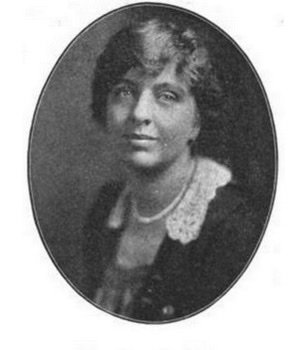“…the most honest, unselfish, indomitable hellcat in the history of conservation.” That’s how a New Yorker writer described Rosalie Edge in a 1948 article. And, I might add, one of the least likely people to end up with that description. Edge came late to her commitment to conservation, but she made up for it with the passion of a true zealot.
Mabel Rosalie Barrow was born in New York City on November 3, 1877 (died 1962). She led an idyllic childhood, favored among her siblings by her successful father, educated in the best schools, enjoying the company of New York’s cultural elite. She travelled widely as a young woman, meeting her future husband on a visit to England. He was later posted to Japan as an engineer, and Rosalie joined him and they were married in Yokohama. After three years in Japan and extensive travel throughout Asia and Europe, they returned to New York.

On her travels, Edge met several leaders of the suffragist movement, which became her first passion. Starting in 1915, she became an active member of the suffrage movement, an unrelenting advocate right through to the passage of the 19th Amendment in 1920. As a suffragette, she learned the basics of leading a social movement—organizing, writing pamphlets, staging protests, engaging other thought leaders. The success of her work gave her an indomitable spirit and a bottomless well of self-confidence. This work would be crucial to her later success as an advocate for conservation.
When her husband left her in 1916 for another woman (she never divorced him and kept his name), Edge found consolation in walks through Central Park. She made friends with bird-watchers that she met in the park and became an avid amateur ornithologist herself (her life-list of species seen in Central Park surpassed 800).
Her life changed while staying in Paris in 1929. The mail from home included a 16-page pamphlet, “A Crisis in Conservation.” It was written by Willard Van Name, a marine invertebrate biologist at the American Museum of Natural History. Among a variety of topics relating to the conservation of birds, the pamphlet described actions ascribed to the National Association of Audubon Societies (now the National Audubon Society) that Van Name thought were contrary to bird conservation. AS Edge’s son, Peter, wrote, “It was this … charge that most aroused my mother as she read the pamphlet that afternoon in Paris, and again as she reread it, many times over, seated in her deck chair aboard the liner taking us back to New York.”
Once back in New York, Edge went to work to reverse the situation. She formed the Emergency Conservation Committee, basically a one-woman advocacy organization (which she ran for decades). Because Van Name had been forbidden by his employer to publish any more such pamphlets, Edge instead published what he wrote under her own name on behalf of the Emergency Conservation Committee. She and her family raised funds, printed and distributed pamphlets to influential persons, a replication of her effort on behalf of women’s suffrage. Over the next several years, Edge distributed more than a million pamphlets on conservation topics.
Her work had enormous and important results. After suing Audubon for their mailing list—and winning—she sent pamphlets to the organization’s entire membership, resulting in changes in leadership and conservation policies (in later years, Edge became a supporter of the reformed group). Again using the effective techniques that she had learned and honed, along with the access to national leaders that her social position allowed, she successfully lobbied the U.S. Congress to create King’s Canyon National Park and Olympic National Park and to expand Yosemite.

Today, however, her greatest legacy—and one she made happen almost single-handedly—is the Hawk Mountain Sanctuary in southeastern Pennsylvania. In 1932, Edge learned that hunters would travel to a certain mountain to shoot birds of prey as they migrated in the spring and fall. The mountain was situated so that air currents encouraged the migrating raptors to fly along the ridge. Thousands of birds were shot annually.
Edge visited the property and, with the passion of purpose that pervaded her life, she bought it—1,400 acres for the price of $2.50 per acre. She declared it a bird sanctuary and hired Maurice and Irma Broun to serve as on-site managers in 1934. As Peter Edge wrote in 1994, “Since the day Maurice and Irma arrived at Hawk Mountain 60 years ago, not a single hawk has been shot.” The Hawk Mountain Sanctuary is purported to be the world’s first preserve dedicated to birds of prey. Today it covers 2,600 acres and has 60,000 visitors each year.
I said at the beginning that Rosalie Edge was an unlikely champion of conservation. It is a nice lead to this story, but you know and I know that it isn’t true. Conservationists come from every background. How we get here is much less important than we arrive. Let us all be like Rosalie Edge, using our innate skills and capabilities to make this world a better place, whether your preferred habitat is Central Park or the middle of nowhere. Each of us matters.
References:
Audubon Center for Birds of Prey. Rosalie Barrow Edge – Feminist, Naturalist and Conservationist. Available at: https://cbop.audubon.org/news/rosalie-barrow-edge-feminist-naturalist-and-conservationist. Accessed July 14, 2022.
Edge, Peter. 1999. Rosalie Edge: A Most Determined Lady (1877-1962). Hawk Mountain Organization. Available at: https://www.hawkmountain.org/download/?id=5359. Accessed July 14, 2022.
Hawk Mountain Sanctuary. About Us. Available at: https://www.hawkmountain.org/about-hawk-mountain-sanctuary. Accessed July 14, 2022.
Moag, Jeff. 2019. How Socialite Rosalie Edge Became the Conscience of American Conservation. Adventure Journal. Available at: https://www.adventure-journal.com/2019/11/how-rosalie-edge-became-the-firebrand-conscience-of-american-conservation/. Accessed July 14, 2022.
Pennsylvania Center for the Book. Rosalie Edge. Available at: https://pabook.libraries.psu.edu/literary-cultural-heritage-map-pa/bios/Edge__Rosalie_Barrow. Accessed July 14, 2022.
